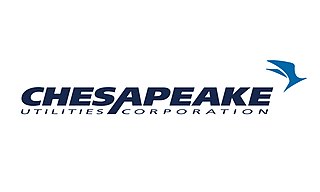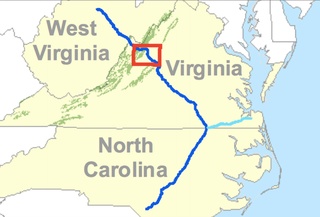
Maryland is a state in the Mid-Atlantic region of the United States, bordering Virginia, West Virginia, and the District of Columbia to its south and west; Pennsylvania to its north; and Delaware and the Atlantic Ocean to its east. The state's largest city is Baltimore, and its capital is Annapolis. Among its occasional nicknames are Old Line State, the Free State, and the Chesapeake Bay State. It is named after the English Queen Henrietta Maria, known in England as Queen Mary, who was the wife of King Charles I.

Natural gas, is a naturally occurring hydrocarbon gas mixture consisting primarily of methane, but commonly including varying amounts of other higher alkanes, and sometimes a small percentage of carbon dioxide, nitrogen, hydrogen sulfide, or helium. It is formed when layers of decomposing plant and animal matter are exposed to intense heat and pressure under the surface of the Earth over millions of years. The energy that the plants originally obtained from the sun is stored in the form of chemical bonds in the gas. Natural gas is a fossil fuel.

The Delmarva Peninsula, or simply Delmarva, is a large peninsula on the East Coast of the United States, occupied by the vast majority of the state of Delaware and parts of the Eastern Shore regions of Maryland and Virginia. The peninsula is 170 miles (274 km) long. In width, it ranges from 70 miles (113 km) near its center, to 12 miles (19 km) at the isthmus on its northern edge, to less near its southern tip of Cape Charles. It is bordered by the Chesapeake Bay on the west, and the Delaware River, Delaware Bay, and the Atlantic Ocean on the east.

Easton is an incorporated town and the county seat of Talbot County, Maryland, United States. The population was 15,945 at the 2010 census, with an estimated population in 2019 of 16,671. The primary ZIP Code is 21601, and the secondary is 21606. The primary phone exchange is 822, the auxiliary exchanges are 820, 763, and 770, and the area code is 410.

Ovintiv Inc. is a hydrocarbon exploration and production company organized in Delaware and headquartered in Denver, United States. Initially, it was founded and headquartered in Calgary, Alberta, and in the mid-2000s was the largest energy company in Canada.
Enbridge Inc. is a Canadian multinational energy transportation company based in Calgary, Alberta. It focuses on the transportation, distribution and generation of energy, primarily in North America. As a transporter of energy, Enbridge operates in Canada and the United States, the longest crude oil and liquid hydrocarbons transportation system in North America. As a distributor of various fuels, it owns and operates Canada's largest natural gas distribution network, providing distribution services in Ontario, Quebec and New York State.

The Eastern Shore of Maryland is a part of the U.S. state of Maryland that lies mostly on the east side of the Chesapeake Bay and consists of nine counties, seven of which have Chesapeake Bay coastlines. The region also contains Maryland's only coast on the Atlantic Ocean.

TC Energy Corporation is a major North American energy company, based in Calgary, Alberta, Canada, that develops and operates energy infrastructure in Canada, the United States, and Mexico. The company operates three core businesses: Natural Gas Pipelines, Liquids Pipelines and Energy.
Chesapeake Energy Corporation is an American energy company engaged in hydrocarbon exploration. It is headquartered in Oklahoma City. The company is named after the founder's love for the Chesapeake Bay region.

Chesapeake Utilities Corporation is an American corporation formed in 1947. Chesapeake Utilities Corporation is a diversified energy company engaged, through our operating divisions and subsidiaries, in various energy and other businesses. Headquartered in Delaware, Chesapeake Utilities Corporation operates primarily within the Middle-Atlantic, Southeast and Midwest regions, providing natural gas distribution and transmission, natural gas supply, gathering and processing, electric distribution and propane distribution service.

Southern Company Gas, formerly AGL Resources, is an American Fortune 500 energy services holding company headquartered in Atlanta, Georgia. The company's operations consist of natural gas distribution, wholesale services, retail operations, and midstream operations. Southern Company Gas is one of the largest natural gas distribution companies in the United States. The company serves approximately 4.5 million utility customers through its regulated distribution subsidiaries across four states. Southern Company Gas made the Fortune 500 list in 2015, Forbes 2000 in 2006, and is a member of the S&P 500 Index. In 2016, Southern Company acquired AGL Resources and renamed it Southern Company Gas.

Hydraulic fracturing in the United States began in 1949. According to the Department of Energy (DOE), by 2013 at least two million oil and gas wells in the US had been hydraulically fractured, and that of new wells being drilled, up to 95% are hydraulically fractured. The output from these wells makes up 43% of the oil production and 67% of the natural gas production in the United States. Environmental safety and health concerns about hydraulic fracturing emerged in the 1980s, and are still being debated at the state and federal levels.

Cove Point LNG Terminal is an offshore liquid natural gas shipping terminal. It is located near Lusby, Maryland, United States, on the western shore of the Chesapeake Bay, which exports liquefied natural gas (LNG) and also stores gas. LNG is exported on specially designed ships known as LNG carriers.
The Chesapeake Climate Action Network (CCAN) is the first grassroots nonprofit organization dedicated exclusively to fighting global warming in Maryland, Virginia, and the District of Columbia. The organization's mission is to foster a rapid societal switch to clean energy and energy-efficient products, joining similar efforts worldwide to address global warming.

Dominion Energy, Inc., commonly referred to as Dominion, is an American power and energy company headquartered in Richmond, Virginia that supplies electricity in parts of Virginia, North Carolina, and South Carolina and supplies natural gas to parts of Utah, West Virginia, Ohio, Pennsylvania, North Carolina, South Carolina, and Georgia. Dominion also has generation facilities in Indiana, Illinois, Connecticut, and Rhode Island.
The Jordan Cove Energy Project is a proposal by Calgary-based energy company Pembina to build a liquefied natural gas export terminal within the International Port of Coos Bay, Oregon. The natural gas would be transported to the terminal by the Pacific Connector Gas Pipeline.

The Marcellus natural gas trend is a large and prolific area of shale gas extraction from the Marcellus Shale or Marcellus Formation of Devonian age in the eastern United States. The shale play encompasses 104,000 square miles and stretches across Pennsylvania and West Virginia, and into eastern Ohio and western New York. In 2012, it was the largest source of natural gas in the United States, and production was still growing rapidly in 2013. The natural gas is trapped in low-permeability shale, and requires the well completion method of hydraulic fracturing to allow the gas to flow to the well bore. The surge in drilling activity in the Marcellus Shale since 2008 has generated both economic benefits and considerable controversy.

Hydraulic fracturing in South Africa is an energy production strategy in early stages of development using high-pressure drilling techniques to release natural gas trapped in shale rock. After initially imposing a moratorium on hydraulic fracturing in April 2011, the South African government lifted the moratorium in September 2012 after an initial investigation by an interdepartmental task team. Several energy companies were subsequently granted exploration licenses. Fracking in South Africa is a current topic of debate, with proponents pointing to substantial economic and energy benefits and opponents voicing concerns about potentially adverse environmental impacts.

The Atlantic Coast Pipeline was a planned natural gas pipeline slated to run 600 miles (970 km) from West Virginia, through Virginia, to eastern North Carolina. It was cancelled in July 2020.














